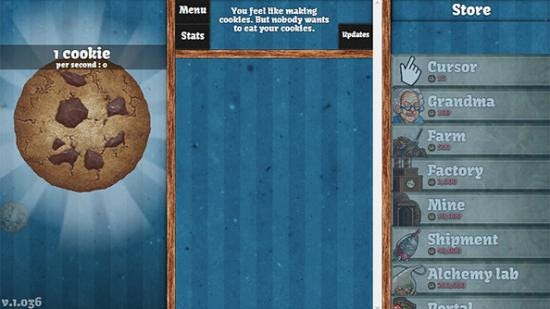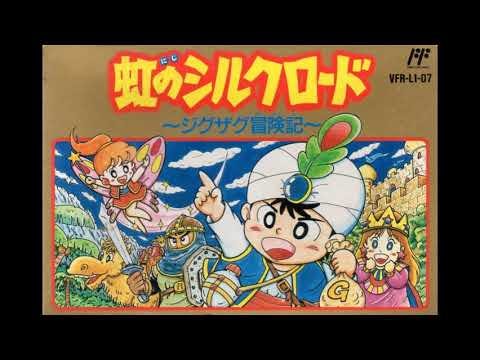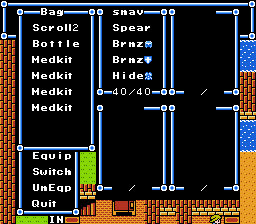I. Mechanism Analysis
Lately I've been playing a ton of JRPGs (completed: Chrono Trigger, Dragon Quest V, Final Fantasy V, Phantasy Star IV, plus some of Ultima IV), most recently a 1989 NES game called Rainbow Silkroad, or Niji no Silkroad in Japan. It was released only in Japan but it’s fan-translated, and it’s part of a subgenre I’ve never seen before. I’ll call it a Mercantile RPG.
The core mechanism of the game is buying and selling goods. You explore various towns along the silk road (actual places!) which sell commodity goods at various prices, and your goal is to make money by buying low and selling high. Each city has fixed prices for goods, so obviously the correct play style is to create a spreadsheet.

This mercantile system is tacked onto a simplified Dragon Quest-like RPG. You have to fetch items, save the princess, collect mirrors or orbs or whatever in dungeons. You talk to NPCs to figure out what to do.
There are random battles outside cities. Dungeons feature forking paths, random battles, chests, often a final boss, and maybe some basic traps like falling through the floor on certain tiles. In battle, you attack, use item, attempt to run, or re-equip your gear. The items usable in battle mainly increase HP or cure status effects like poison, although there’s some other items I never tried like bomb and smoke. I’ve never found a reason to re-equip.
There’s no experience system. No levels. No stats except HP and a hidden damage stat, which only goes up when you buy new equipment. All you see in battle is HP: no mana, no D&D style Str, Int, Dex, etc. attributes. You have an "H20" bar that decreases as you travel, to limit the maximum length of travel without returning to a city or oasis, but it’s seemingly not used in battle. Apparently if it hits 0 you start taking dehydration damage. Never happened to me.
You can recruit (= buy) up to 3 “army” members for a max party size of 4. More party members means more enemies encountered. All they can do is attack. You can equip them with armor and weapons to increase their HP and damage. They can die without a game over (where a game over typically resets you back to the most recent save point), and then you can recruit another. There’s no other “unique” characters you can add to your party.

Why battle at all? Battles add some risk to traveling between cities, and they also give you LP or license points, which you spend on trade licenses that permit you to buy and sell more expensive and profitable goods. First you get coal and oil, then onyx and jade, then furs, etc. Your goods are kept in a separate inventory from your items, which are only quest-related or battle-related, and you can increase your inventory space by buying animals, such as camels, horses, etc. More space for goods means you can trade greater volumes and make more money per trip.

And that’s the entire game! I only got through the first of the major areas, Arabia, because I quickly realized there wasn’t much else to learn, and the actual gameplay isn’t particularly fun. You trade, grind, and do fetch quests, until you beat the game.
The upshot to the game being so simple is that it’s ripe for analysis. I can chart out the entire mechanism system underlying the game. Might look like a lot, but it’s far simpler than most other RPGs:
You should recognize every “gear” above from the descriptions I provided of the various in-game mechanisms. Note that I divided the diagram in half: this green line represents a fundamental tension inherent to all RPGs, made obvious when your aim is to maximize wealth. This is the tension between power and completion. In other words: are you trying to be strong? Or are you trying to “beat the game” (story)? Of course, there’s usually a minimum level of strength required to complete the storyline, but every JRPG I’ve played thus far is effectively two games: a battling dungeon crawler, and an exploration puzzle adventure.
II. Critique
What’s the purpose of this tension, between power and completion? Why is it so prevalent? How does each side work? My theory at the current moment is that the two are inextricably tied together as part of what I’ll call the fundamental psychology of the JRPG. Put simply, there are two competing concerns in designing a JRPG: (1) the player wants to experience a sense of agency, they want to feel that their actions have meaning within the context of the game world, and (2) the technological constraints of digital games mean that the story must be predetermined, on rails. Predetermined does not mean linear necessarily (e.g. SaGa, which I would like to play soon), but it means that the entire story is known and written before the gamer even starts their play-through.
When outcomes are predetermined, the choices one makes cease to have meaning, because the set of results are the same either way. So, how can a predetermined story make the player feel like their choices are meaningful? The answer since the original Dragon Quest and earlier has been to offer a “false choice” dependent on your character’s power: either you become strong enough to continue the story, or not (maybe you die, get a game over, have to try again). The fact that you need to achieve a threshold makes it feel like your actions are moving the story along, vs a story that would proceed “no matter what” (even though this is the case in actuality, if player strength and battles were removed from the game).
This false choice takes place within a “battling and dungeon crawling minigame”, which includes an aspect of increasing your character power through “grinding”, which is an activity Burgun would call “labor”. You can imagine the simplest possible JRPG, maybe designed for a smartphone, where you walk around solving simple puzzles that advance the plot, and occasionally need to play a modified “Cookie Clicker”, where you need to push the button repeatedly to advance the story. This wouldn’t be so different from how the battle system functions in simple JRPGs, and the fact remains that some people love Cookie Clicker, because, well, number go up.

Grinding is essential to the standard JRPG. Without grinding (and another game to replace it, such as tactical challenges), JRPGs become something closer to interactive adventure novels, which found their own popularity in the Visual Novel format. Or, you get a “puzzle game” like the Legend of Zelda series, where the challenge in the game is to reverse engineer what the developers had in mind in order to move onto the next beat. I personally dislike Legend of Zelda because of how on-rails it feels; I would rather play Cookie Clicker.
Burgun makes the same point in Clockwork Game Design with a discussion of the board game Monopoly:
Labor plays an interesting trick on us. Everyone has played the board game Monopoly, usually with house rules that make the game (not a great game to begin with) far worse. For instance, many people play Monopoly without bidding for properties. When played this way, there are essentially no decisions to make in the game, other than possibly “should I buy this property I just landed on,” which is mostly solved. Yet, people have been playing Monopoly in that way for years. If they have essentially no decisions to make, then shouldn’t they be getting more bored with it more quickly?
One answer is actually the way money works in the game. Prices for properties generally are non-rounded amounts like $142, yet the bills in the game are all normal money denominations of $1, $5, $10, $20, $50 and so on. What this means is that any time a money transaction has to happen—which is almost every turn—players have to “break bills” and “get change.” The combination of the light arithmetic that needs to be done to do that and the physical activity of breaking bills creates an illusion of “doing something.” It’s just enough to occupy most adult’s brains to keep them from remembering that they have no decisions to make.
The reality is that designers consciously and unconsciously use this same technique to distract players from other similarly-solved systems. In many RPGs, what you have to do is obvious and solved—bring this item to that point on the map—but in order to do it you have to walk all that way. Not only that, but along the way you have to fight random encounter battles, each of which are also totally solved, but have just enough “bill-breaking” type activity for you to do to keep your brain occupied.
As an example, the combat in a game like Final Fantasy is quite similar to the task of breaking bills. A character with a powerful attack is kind of like a large bill—you have to make sure to put it in the right spot. A character with a lighter attack is kind of like a $10 added onto a $100 to meet the $110 price.
To return to Rainbow Silkroad, it’s clear that the battle mechanics are a form of labor. There’s even less you can do than in most JRPGs, since you don’t have spells or multiple attacks: just one base “attack”. However, it also has a buying and selling mechanic, which is more interesting, in that it does require decision-making: which goods to buy and where to trade them.
But, prices never change and are only different between cities, so the game itself is easy to solve, in that you can find the optimal trade routes and simply execute them repeatedly. The random battles and H20 meter could provide risk requiring strategic choices in terms of where to trade, but in practice they’re easy enough to account for that you never really fear you won’t make your destination, as long as you have a few Medkit items in case you get bad RNG and take some damage.
So, what could we do to make the game better?
III. Routes Not Taken
Burgun claims that the fundamental idea of a game revolves around decision-making in conditions of epistemic uncertainty. Fun itself is a derivative property of games that have tight feedback loops for decision-making where the player can improve their skills over time. Thus the core approach we can take to “how could Rainbow Silkroad be a better = more fun game?” is to address the question of “how can we introduce (bounded) uncertainty in decision-making?”
For the purpose of our thought experiment, let’s assume there’s no battle mechanism or storyline. The point of the game would be to make as much money as you can, maybe within a certain time limit or until some condition occurs, such as making N total trades (alternatively, we could choose a condition like quickest time or fewest trades to accumulate X amount of money, which would mirror the divide between “fastest possible” vs “as much as possible” in e.g. Katamari Damacy).
For a pure accumulation game, do we even need a little character on a 2D map? Could we simply have a menu of cities with goods and prices, and maybe some notion of time and failure risk for trades between cities? That would be a simple game, and the uncertainty of completing each trade would add some risk, but it would also be relatively unfun or frustrating, because the simple “X% chance of failure to trade” doesn’t exactly lead to excitement, especially if the intent is to compare your score with other players, or with your past results. It would feel like a game of chance.
Another idea would be to have floating prices for goods, sort of like how the actual equities market works. You would have to make guesses about which goods are going to increase or decrease in price. That could be fun, and is in fact the core mechanic of a standard “stock market simulator” game.
Regardless of the buying and selling mechanism choices listed above, a major part of the fun of Rainbow Silkroad comes from the element of exploring the historical Silk Road and trading on it. So perhaps we could continue to dispense with battles, but keep the top-down movement, maybe add in a notion of date/time (so you can travel at night to finish your route faster, but it makes travel more dangerous), random weather events, and maybe warfare events you could influence through various financial and political means. Maybe you can discover shortcuts with trade-offs, like paying to use a gate, or traversing difficult terrain. In other words: go all in on trading, rather than slapping a trading sim onto a bad Dragon Quest clone.
These are just some ideas for how Rainbow Silkroad could be a better game. Feel free to drop your own ideas in the comments. Last thing I’ll mention: some of the soundtrack absolutely slaps (for its time), so please enjoy the friendly melody that plays as you wander the Ancient East:











This makes me want to play Dope Wars again. If you haven't played it, it's a 1980's small time drug dealer simulator played entirely through menus. You start out with debt to a bookie that you have to pay down by a deadline and if you don't pay it you'll have to deal with mob goon random encounters. The actual game involves traveling between areas in the city and buying and selling drugs based on street market prices which fluctuate. You also have random events like the DEA doing a big bust causing the prices of some drugs to skyrocket for a time. Of course you can get hassled by cops and have other random encounters. I think something like this laid onto a 2D map game might be fun.